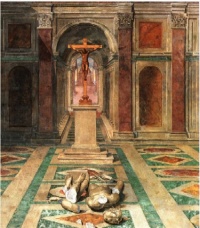Paganism
From The Art and Popular Culture Encyclopedia
|
"'For Sinistrari d'Ameno,' observed Durtal, "'the incubi and succubi are not precisely demons, but animal spirits, intermediate between the demon and the angel, a sort of satyr or faun, such as were revered in the time of paganism, a sort of imp, such as were exorcised in the Middle Ages. Sinistrari adds that they do not need to pollute a sleeping man, since they possess genitals and are endowed with prolificacy.'"--Là-Bas (1891) by Joris-Karl Huysmans |

|
Related e |
|
Featured: |
Paganism (from Late Latin paganus, meaning "country dweller", "rustic", "civilian", "non-combatant") is a broad term typically pertaining to indigenous and historical polytheistic and non-theistic religious traditions - primarily those of cultures known to the classical world.
In a wider sense, it has been used as a label for any non-Abrahamic folk/ethnic religion. It was historically used as one of several pejorative Christian counterparts to "gentile" (גוי) as used in the Hebrew Bible - comparable to "infidel" or "heretic". Modern ethnologists often avoid this broad usage in favour of more specific and less potentially offensive terms such as "polytheism", "shamanism", "pantheism", or "animism" when referring to traditional or historical faiths.
Since the 20th century, "Paganism" (or "Neopaganism") has become the identifier for a collection of new religious movements attempting to continue, revive, or reconstruct historical pre-Abrahamic religion.
Contents |
Historical paganism
In the Christian perspective the term has been used historically to encompass all non–Abrahamic religions. The term pagan is a Christian adaptation of the "gentile" of Judaism, and as such has an inherent Abrahamic bias, and pejorative connotations among monotheists, comparable to heathen and infidel. Words such as kafir (كافر) and mushrik (مشرك) are similarly used by Muslims. Peter Brown observes:
The adoption of paganus by Latin Christians as an all-embracing, pejorative term for polytheists represents an unforeseen and singularly long-lasting victory, within a religious group, of a word of Latin slang originally devoid of religious meaning. The evolution occurred only in the Latin west, and in connection with the Latin church. Elsewhere, "Hellene" or "gentile" (ethnikos) remained the word for "pagan"; and paganos continued as a purely secular term, with overtones of the inferior and the commonplace.
Bronze Age to Early Iron Age
- Religions of the Ancient Near East
- reconstructed Proto-Indo-European religion
- Proto-Indo-Iranian religion
Classical Antiquity
Ludwig Feuerbach (1833) defines "Paganism" (Heidentum) in the context of classical antiquity as "the unity of religion and politics, of spirit and nature, of god and man", qualified by the observation that "man" in the Pagan view is always defined by ethnicity, i.e. Greek, Roman, Egyptian, Jew, etc., so that each Pagan tradition is also a national tradition. Feuerbach goes on to postulate that the emergence of monotheism and thus the end of the Pagan period was a development which naturally grew out of Hellenistic philosophy due to the contradiction inherent in the ethnic nature of Pagan tradition and the universality of human spirituality (Geist), finally resulting in the emergence of a religion with a universalist scope in the form of Christianity.
Late Antiquity
The developments of Late Antiquity in the religious thought in the far-flung Roman Empire needs to be addressed separately, as this is the context in which Early Christianity itself developed as one of several monotheistic cults, and it was in this period that the concept of "pagan" developed in the first place. Christianity as it emerged out of Second Temple Judaism (or Hellenistic Judaism) stood in competition with other religions advocating "pagan monotheism", including Neoplatonism, Mithraism, Gnosticism, Manichaeanism, and the cult of Dionysus.
Dionysus in particular exhibits significant parallels with Christ, so that numerous scholars have concluded that the recasting of Jesus the wandering rabbi into the image of Christ the Logos, the divine saviour, reflects the cult of Dionysus directly. They point to the symbolism of wine and the importance it held in the mythology surrounding both Dionysus and Jesus Christ; Wick argues that the use of wine symbolism in the Gospel of John, including the story of the Marriage at Cana at which Jesus turns water into wine, was intended to show Jesus as superior to Dionysus. The scene in The Bacchae wherein Dionysus appears before King Pentheus on charges of claiming divinity is compared to the New Testament scene of Jesus being interrogated by Pontius Pilate.
For these reasons, it is difficult if not impossible to draw a clear line between "Christianity" and "Paganism" for the period of the 3rd to 4th centuries when Christianity was in its formative phase. Only with the emergence of Orthodox Christianity as reflected in the Apostle's Creed and the final decline of Hellenistic paganism by the 6th century does "Paganism" become a concept clearly distinct from Christianity.
Ethnic religions of pre-Christian Europe
- Armenian paganism
- Baltic paganism
- Celtic polytheism
- Finnic paganism
- Germanic paganism
- Slavic paganism
- Vainakh paganism
See also
- Animism
- Folk religion
- Idolatry
- List of Pagans
- Myth and ritual
- Mythology
- Neopaganism
- Polytheism
- Religion and mythology
- Shamanism
- Wicca

